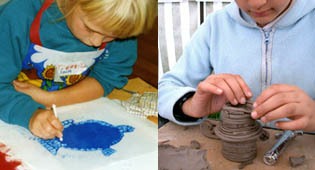











facing the future
Telling stories
A large part of digital media and the internet is used as a form of individual storytelling and communication -
In his book 'How Art Made The World' Nigel Spivey devotes a whole chapter to the origins of storytelling, and relating it directly with our experiences today.
He says:
"Once upon a time there was a story.
It was told, we suppose, to people crouched around a fire: a tale of adventure, most likely -
Whatever its thread, the weaving of this story was done with a prime purpose. The listeners must be kept listening. They must not fall asleep. So, as the story went on, its audience should be sustained by one question above all. What happens next?"
"... to this day storytime is probably most often associated with words on paper... the formal practice of narrating a story aloud would seem -
Each year over 7 billion people across the world will go to watch the latest offering from Hollywood, Bollywood and beyond.... The supreme storyteller today is cinema."
"... the power of dramatic forms of communication are more direct and evocative than plain language"
resource link > Nigel Spivey: How Art Made The World
The activity telling stories and developing relationships through exchanging ideas seems an essential part of human existence. Stories have traditionally been handed down through the generations by being retold countless times from memory, functioning as an essential means for passing on information. Writing liberated this process to allow permanent records to be kept, and cinema & TV allowed mass audiences to experience the stories. Now digital media is changing our experiences and relationships yet again.
Steven Johnson, in his book ‘Where Good Ideas Come From’ (publ. 2010) describes the special nature of YouTube:
"YouTube radically altered the basic rules of the medium. For a start it made watching video on the web a mass phenomenon. But with YouTube you weren't limited to sitting and watching a show, television style, you could also upload your own clips, recommend or rate other clips, get into a conversation about them. With just a few easy keystrokes, you could take a clip running on someone else’s site and drop a copy of it onto your own site. The technology allowed ordinary enthusiasts to effectively program their own private television networks stitching together video clips from all across the planet."
resource link > Steven Johnson: Where Good Ideas Come From
Digital media is liberating everyone from the limitations of being just a receptive audience. Now all our voices can be heard through these new dramatic and interactive visual, verbal and musical ways of telling stories. This is not only altogether more animated and interesting than the printed page, it creates new means of expression and new types of relationships for all.
what do we mean -
• there is special knowledge and understanding to be gained by making things
• childhood plays a vital part in this innovative process
a historical perspective
• observation, trial and error
• origins of maths
• patterns and geometry
facing the future
growing concerns
• Neil MacGregor
• Sherry Turkle
• Seymour Papert